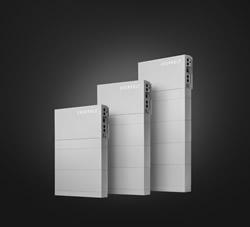Like all of the New Jersey National Guard's solar power projects, this project is under the State of New Jersey's Solar Renewable Energy Certificate Program. Under this program, solar system owners that generate over 1,000 kilowatts of electricity per year that's connected to the public power grid, receive certificates.
The Power to Save Lives
JoAnne Castagna, Ed.D. | U.S. Army Corps of Engineers
After the water receded and wind settled after Superstorm Sandy, the New Jersey National Guard was out rescuing citizens. Whether they found that young child under the rubble or safely guided an elderly man out of his home, was a direct result of the work being performed by the task force at the Homeland Security Center of Excellence, Headquarters in New Jersey.
"Emergencies are our number one priority," said Sgt. 1st Class Richard E. St. Pierre, who works at the center that is part of the New Jersey Department of Military and Veterans Affairs. "It's our responsibility to find roads that are safe for our teams to go out on to rescue people. Without an emergency operations center like ours, quick and efficient response to any emergency would be hindered if not incapacitated completely."
The effective operation of this center includes making sure it has power. This summer the U.S. Army Corps of Engineers, New York District completed the construction of a solar power project to provide power to the center. This is the fifth solar power project the Army Corps has helped construct for the New Jersey Army National Guard.

Solar Power Project at the Homeland Security Center of Excellence in Lawrenceville, N.J. Credit NJ National Guard.
The project is not only supporting a center that is saving lives during natural and man-made disasters, but also providing the center 61 percent of its annual energy needs and saving the National Guard and taxpayers' considerable money.
"This project is enhancing homeland security," said Jose Diaz, project manager, U.S. Army Corps of Engineers, New York District. "The overall effort in the use of renewable energy resources is to provide a level of energy security that will allow operation of our military facilities against any future fuel shortages, embargos, as well as natural disasters."
Army Corps contractor P&S Construction, Inc. of Lowell, MA performed the work that involved installing 300 solar power panels on a 16,775 square foot area of roof on a warehouse adjacent to the center.
These panels were added to a panel system that was already on the warehouse roof, boosting their renewable energy capabilities from 321 Kilowatts to 550 Kilowatts.
Panel arrays are composed of modules made up of several solar cells or photovoltaic cells that absorb sunlight that produce electricity. The larger the panel, the more electricity is produced.
Electricity in the form of direct current is produced by the panels, which is not directly usable energy for a building. Most buildings require alternating current at a higher voltage. To make usable building power, the solar panel's direct current is fed into an inverter that transforms it into alternating current at a higher voltage.
This alternating current power is then sent to the building's main transformers where it can be used by the building for its energy needs.
The enhanced solar power system is providing the center approximately 61 percent of its annual energy needs and reducing the center's demand on the electrical grid during the highest and most costly energy demand days during the peak summer months.
"These roof mounted systems will provide a future cost avoidance to the National Guard and save taxpayer's approximately $110,000.00 annually," said Diaz.
This project is also tied to the public power grid so that excess energy can be shared with the community.
Like all of the New Jersey National Guard's solar power projects, this project is under the State of New Jersey's Solar Renewable Energy Certificate Program. Under this program, solar system owners that generate over 1,000 kilowatts of electricity per year that's connected to the public power grid, receive certificates.
These certificates are then publicly sold and traded to New Jersey businesses and individuals, enabling them to receive solar power benefits without building a solar power system themselves. The revenue is returned to the solar system owners.
This won't be the last solar power project the Army Corps creates for the New Jersey National Guard. They are starting another project at the New Jersey National Guard's National Training Facility Headquarters in Sea Girt. They are constructing a 500+ Kilowatt carport system to help create a net zero installation, an installation that produces as much energy on the site as it uses over the course of a year.
"These projects are helping the New Jersey National Guard reach its renewable energy goals. The Guard wants 25 percent of its power to come from renewable energy sources by 2020," said Diaz.
Diaz added, "In addition, this solar power system will also help conserve valuable natural resources, improve air quality due to the fuel free nature of solar electricity generation and serve as a showcase for integrating renewable energy into military facility operations."
Dr. JoAnne Castagna is a Public Affairs Specialist and Writer for the U.S. Army Corps of Engineers, New York District. She can be reached at joanne.castagna@usace.army.mil. Follow her on Twitter at http://twitter.com/joannecastagna
To learn more about this and other New Jersey National Guard solar power projects visit: www.sunviewer.net/portals/NJNG/
The content & opinions in this article are the author’s and do not necessarily represent the views of AltEnergyMag
Comments (0)
This post does not have any comments. Be the first to leave a comment below.
Featured Product

